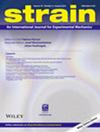基于图像的惯性冲击试验,用于粘弹性结构识别:误差量化的数字复制品
IF 1.8
3区 材料科学
Q2 MATERIALS SCIENCE, CHARACTERIZATION & TESTING
引用次数: 0
摘要
聚合物广泛应用于承受冲击负荷的场合。因此,了解其机械响应的时间依赖性对于设计高应变率环境下的结构至关重要。然而,在微秒时间尺度上描述这些材料的特性已被证明具有挑战性。传统的实验技术依赖于满足一系列限制性假设,通常无法提供材料参数的直接测量值。在这里,我们提出了一种基于图像的惯性冲击(IBII)试验的新实施方法,利用虚拟场方法的应力计实施来提取微秒时间尺度上的粘弹性组成参数。我们采用数字复制方法对实验进行验证,首先在粘弹性材料的 IBII 试验有限元模型上提取构成参数。然后使用有限元数据对计算机生成的网格图像进行合成变形,再用灰度级噪声对这些图像进行污染,以模拟真实实验中捕获的图像。对这些图像的处理与物理实验相同,并使用从计算机生成的图像中提取的全场位移重复进行识别,以确定理想的处理参数。结果发现,参数识别在很大程度上取决于用于从全场图像中提取运动场的处理参数,这强调了在尝试物理实验提取构成参数之前进行计算验证的必要性。研究发现,IBII 实验方法能够同时识别体积模量和剪切模量及其相关的时间常数。本文章由计算机程序翻译,如有差异,请以英文原文为准。
Image‐based inertial impact test for viscoelastic constitutive identification: A digital replica for error quantification
Polymers find widespread use in applications where they are subjected to impact loading. Therefore, understanding the time dependence of their mechanical response is critical to the design of structures subjected to these high strain rate environments. However, characterising these materials on microsecond time scales has proven challenging. Traditional experimental techniques rely on satisfying a number of limiting assumptions and typically do not provide direct measurements of the material parameters. Here, we propose a novel implementation of the image‐based inertial impact (IBII) test to extract viscoelastic constitutive parameters on these microsecond time scales using the stress gauge implementation of the virtual fields method. We validate the experiment using a digital replica approach in which the constitutive parameters are first extracted on a finite element model of an IBII test on a viscoelastic material. The finite element data are then used to synthetically deform computer‐generated grid images, which are then polluted with grey‐level noise to simulate the images that would be captured in a real‐life experiment. These images are processed identically to a physical experiment, and the identification is repeated using the full‐field displacements extracted from the computer‐generated images to determine the ideal processing parameters. Parameter identification was found to strongly depend on the processing parameters used to extract the kinematic fields from full‐field images, emphasising the need for computational validation before attempting a physical experiment to extract constitutive parameters. The IBII experimental method was found to be capable of simultaneously identifying the bulk modulus and the shear modulus along with their associated time constant.
求助全文
通过发布文献求助,成功后即可免费获取论文全文。
去求助
来源期刊

Strain
工程技术-材料科学:表征与测试
CiteScore
4.10
自引率
4.80%
发文量
27
期刊介绍:
Strain is an international journal that contains contributions from leading-edge research on the measurement of the mechanical behaviour of structures and systems. Strain only accepts contributions with sufficient novelty in the design, implementation, and/or validation of experimental methodologies to characterize materials, structures, and systems; i.e. contributions that are limited to the application of established methodologies are outside of the scope of the journal. The journal includes papers from all engineering disciplines that deal with material behaviour and degradation under load, structural design and measurement techniques. Although the thrust of the journal is experimental, numerical simulations and validation are included in the coverage.
Strain welcomes papers that deal with novel work in the following areas:
experimental techniques
non-destructive evaluation techniques
numerical analysis, simulation and validation
residual stress measurement techniques
design of composite structures and components
impact behaviour of materials and structures
signal and image processing
transducer and sensor design
structural health monitoring
biomechanics
extreme environment
micro- and nano-scale testing method.
 求助内容:
求助内容: 应助结果提醒方式:
应助结果提醒方式:


